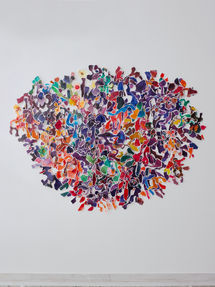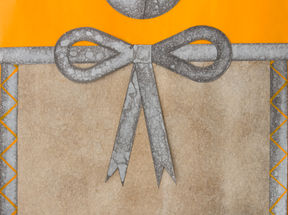bEam arts
ARTIST RESIDENCY & GALLERY IN THESSALONIKI
UNFOLDING
25 April – 28 April 2025
First view: Thursday 24 April, 6–9p.m.

In the fourth cycle of bEam arts artist residency, the two artists María Javiera Castillo and Kristina Mukhacheva, using different means and directions end up arriving at the same idea: Artistic exploration through playful ways and the creation of play conditions through artistic creation itself. Through their playful approaches, the works for the exhibition The zone for playfulness emerge. In addition to the visual objects, the exhibition contains elements of interaction and performance.
Maria Javiera Castillo is originally from Chile, has a degree in Fine Arts and her work focuses on visual installations. Through her artwork she explores the sense of childhood, naivety and nostalgia. The main material she uses is the small colored “plexi flexi” rubber bands with which children make jewelry and small handcrafts.
With these, she weaves large colored ropes that she then integrates into the space, creating unpredictable and playful conditions. The artworks she created during her stay at bEam arts are further experimentation on the idea of play as a material, both tangible and symbolic. A long black and white plexi flexi rope that invites the audience to play with it, a large colored knitted piece reminiscent of a mermaid's tail, an installation with children's toys and hula hoops. A colorful and interesting microcosm that invites us to think about how we too can derive the joy of childhood.
Kristina Mukhacheva has been living in Frankfurt for many years. Her work draws inspiration from both science fiction and ancient myths. Through these she attempts to redefine old narratives as visions of the future, combining organic aesthetics with technological elements. The media she uses are sculpture, public installations, drawing, engraving and performative elements. With all of these, she creates a dialogue between the tactile and the digital. Her practice reflects a seamless fusion of natural forms and futuristic ideas, shaping a very special and unique artistic language.
During her stay in Thessaloniki, she decided to explore the story of the mermaid Thessaloniki, the sister of Alexander the Great, from whom the city took its name. Feeling unsatisfied with the narratives she found, all focused on the importance of her relationship with Alexander, essentially always putting her in the background, she decided to retell her own story. She identifies herself and plays two roles at the same time, that of the archaeologist and that of Thessaloniki, telling the story from two sides. The work she presents has multiple mediums and layers. Sculptures from found objects, sketches, a poem and a performance. Through all of this, she tells us, through her own feminine and feminist gaze, the story of a Thessaloniki that seeks change and the overcoming of the male-centric narrative at the center of which lies war and destruction, seeking freedom and peace itself.
INSTALLATION












